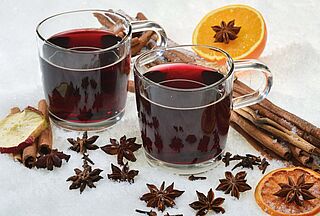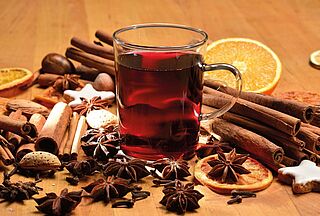Details
Vintner's "Glühwein" (mulled wine): List of providers
When using sweet or medium dry red wines from German growing regions correspondingly less sweetening is necessary.
Here is how it works (ingredients):
- take a litre of German red wine,
- sweeten it to taste with candied sugar or honey
- and then add a slice of (untreated) lemon or orange, four cloves and a stick of cinnamon.
- Small pieces of apple can be added to refine the flavour.
Directions: Warm up the Glühwein preparation at medium heat. Do not allow the mixture to boil as this would lead to the loss of the delicate fruit aromas. Then simmer at a low heat for about 15 minutes. Remove the spices from the wine before serving. Glühwein is best served in a tea or grog glass.
Recommended grape varieties: Fruity red wines from the 13 German growing regions are especially suitable for making a good Glühwein. By heating the wine the aromas which are often reminiscent of red fruit are particularly strongly expressed and create a wonderful harmony with the seasoning ingredients.
Red wine varieties with a low tannin content are especially suitable for Glühwein, for example Portugieser or Spätburgunder (Pinot Noir). People from Württemberg will surely prefer a Trollinger or Lemberger, connoisseurs who like stronger flavours will use a Dornfelder.
Besides this classic red Glühwein there is also a white Glühwein variety: Use white wine and replace the cloves with a handful of raisins and you get what in Northern Germany is called a “hot seal”. For this, grape varieties with subtle acidity, such as Silvaner or Müller-Thurgau, are especially suitable.
Seasoning the wine: The seasoning of wine has a long tradition in the wine world. Even the ancient Romans sometimes flavoured their wine with sugar and spices. As early as 30 BC, Apicius mentions a recipe for spiced wine which is similar to recommendations for Glühwein today: cinnamon, bay leaf, star anise, coriander and thyme as well as a large portion of honey were to be added to the wine to make it keep longer and make it more enjoyable.
At that time, many wines could probably do with an improvement to the flavour by adding spices. Today, things look quite different, and it is worth paying attention to the quality of the base wine when making Glühwein.
Vintner’s Glühwein is very popular
Meanwhile, many vintners offer ready-to-drink Glühwein produced from individual recipes. Vintner’s Glühwein can also be found in most Christmas markets – especially in the wine growing regions. Have a look on this list (pdf).


